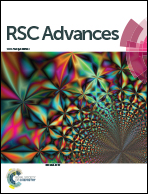Three-dimensional clusters of peony-shaped CuO nanosheets as a high-rate anode for Li-ion batteries
Abstract
Copper oxide (CuO) has emerged as a promising anode material for lithium-ion batteries (LIBs) due to its high theoretical capacity, low cost and low toxicity to the natural environment. However, the low electronic/ionic conductivity and the imponderable volume expansion problem during the charge and discharge process hinder its practical applications. Herein, we introduced three-dimensional clusters of peony-shaped CuO nanosheets (TCP-CuO) to tackle these problems by increasing the surface of the active material. The unique three-dimensional peony-liked structure not only alleviates the volume expansion problem, but also enhances the electron/ion conductivity. As a result, the TCP-CuO electrode possesses a reversible high capacity of 641.1 mA h g−1 at 0.1 A g−1 after 80 cycles as well as an outstanding rate performance of 531.6 mA h g−1 at a rate of 5C (1C = 674 mA g−1) and excellent cycling durability of 441.1 mA h g−1 at 1 A g−1 after 100 cycles. This work demonstrated a novel strategy for the construction of a well-designed structure for other advanced energy-storage technologies.



 Please wait while we load your content...
Please wait while we load your content...